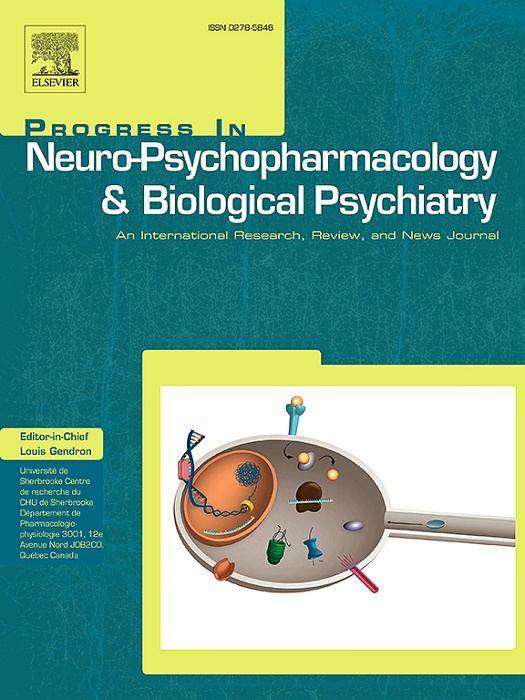Predicting the response to Lorazepam in catatonia: a network analysis approach
IF 3.9
2区 医学
Q1 CLINICAL NEUROLOGY
Progress in Neuro-Psychopharmacology & Biological Psychiatry
Pub Date : 2025-07-05
DOI:10.1016/j.pnpbp.2025.111435
引用次数: 0
Abstract
Background
Lorazepam, a widely used benzodiazepine, is the first-line treatment for catatonia. In case of resistance to Lorazepam, a trial-and-error approach is usually followed, increasing the risk of severe medical complications. To date, the mechanisms underlying non-response to Lorazepam remain unclear. The aims of this study were to determine whether network analysis can identify symptom-based predictors of response to Lorazepam and assess whether the structure of catatonic symptoms differs between responders and non-responders.
Methods
A cohort of patients with catatonia (n = 136) was recruited at a specialized clinical center. Network analyses were conducted using the Bush-Francis Catatonia Rating Scale items, to describe the structure of catatonic symptoms in responders and non-responders to Lorazepam. Symptom clusters were identified using a spinglass algorithm and centrality measures were compared between groups. Additionally, network outcome analyses were performed to identify clinical predictors of Lorazepam response.
Results
Three clusters of catatonic symptoms were identified, with similar structure between responders and non-responders. No significant differences were found in centrality measures. The most central symptoms were characteristics of hyperkinetic catatonia. Immobility / stupor emerged as the unique direct predictor of response to Lorazepam.
Conclusion
The overall structure of catatonic symptoms appears stable between responders and non-responders. Hypokinetic symptoms, particularly immobility and stupor, serve as strong predictors of Lorazepam response. Given the critical need for early treatment prediction to optimize therapeutic interventions and reduce catatonia-related mortality, further research is needed to refine clinical predictors of Lorazepam response.
预测紧张症患者对劳拉西泮的反应:一种网络分析方法。
背景:劳拉西泮是一种广泛使用的苯二氮卓类药物,是治疗紧张症的一线药物。在对劳拉西泮有耐药性的情况下,通常采用试错方法,这增加了严重并发症的风险。迄今为止,对劳拉西泮无反应的机制尚不清楚。本研究的目的是确定网络分析是否可以识别对劳拉西泮反应的基于症状的预测因素,并评估有反应者和无反应者之间紧张症状的结构是否不同。方法:在一个专门的临床中心招募了一组紧张症患者(n = 136)。使用Bush-Francis紧张症评定量表项目进行网络分析,以描述劳拉西泮反应者和无反应者的紧张症症状结构。使用spinglass算法识别症状群,并比较各组之间的中心性度量。此外,进行网络结果分析以确定劳拉西泮反应的临床预测因素。结果:确定了三组紧张症状,反应者和无反应者之间具有相似的结构。中心性测量没有发现显著差异。最核心的症状是高运动性紧张症的特征。静止不动/麻木是对劳拉西泮反应的唯一直接预测因子。结论:有反应者和无反应者的紧张症状总体结构稳定。运动不足症状,特别是不动和麻木,是劳拉西泮反应的有力预测因子。鉴于迫切需要进行早期治疗预测以优化治疗干预措施并降低紧张症相关死亡率,需要进一步研究以完善劳拉西泮反应的临床预测因子。
本文章由计算机程序翻译,如有差异,请以英文原文为准。
求助全文
约1分钟内获得全文
求助全文
来源期刊
CiteScore
12.00
自引率
1.80%
发文量
153
审稿时长
56 days
期刊介绍:
Progress in Neuro-Psychopharmacology & Biological Psychiatry is an international and multidisciplinary journal which aims to ensure the rapid publication of authoritative reviews and research papers dealing with experimental and clinical aspects of neuro-psychopharmacology and biological psychiatry. Issues of the journal are regularly devoted wholly in or in part to a topical subject.
Progress in Neuro-Psychopharmacology & Biological Psychiatry does not publish work on the actions of biological extracts unless the pharmacological active molecular substrate and/or specific receptor binding properties of the extract compounds are elucidated.

 求助内容:
求助内容: 应助结果提醒方式:
应助结果提醒方式:


